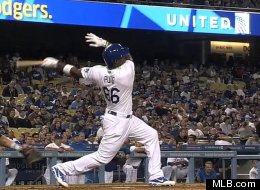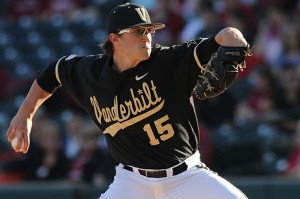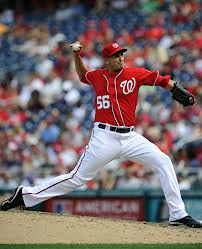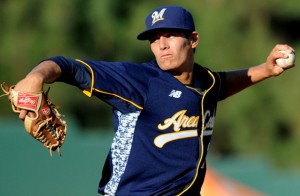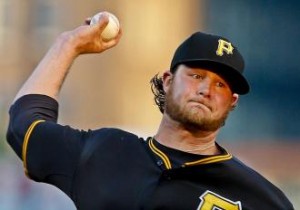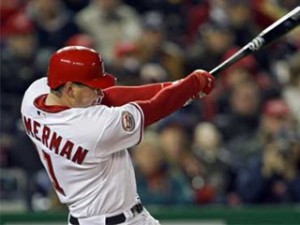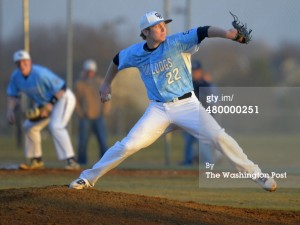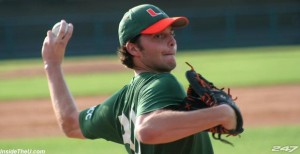
Suarez is the Nats 2nd round pick. Photo via 247sports.com
As we did last year, here’s a quick introduction to the Nats top 10 picks for 2014.
A quick glance on our high-end draftees from 2014 draft. I’ll put in the rankings from several prospect ranking shops (Keith Law, Baseball America, MLB.com and MinorLeagueBall). overall player ranking after the player name where appropriate (though as we’ll see, Keith’s top 100 quickly runs out of names). Here’s a link to the draft order, and here’s a link to MLB.com’s fantastic draft tracker database for reference.
As he did last year, NatsGM.com‘s Ryan Sullivan is live-blogging and does a great job of pulling up stats on each of our picks. I depend on his reports as well as those from the four links above to give a quick overview of our draftees.
Note: I wrote most of this over the weekend as the guys were picked; we’re already hearing plenty of rumors about signings. I havn’t updated this post with such intel but I’m sure its readily available from Ladson and Kilgore and the like.
1st round/#18 overall: Erick Fedde, UNLV RHP (Law #27/BA #24/MLB #33/MinorLeagueBall #70). Most of the credible mock drafts had the Nats drafting Fedde here, and that’s exactly what happened. In my quickie preview post, I thought Fedde would be an overdraft and hoped that either Tyler Beede or Brandon Finnegan would drop. Well, Beede went 14th and Finnegan went 17th. I liked Touki Toussant as well as a prep HS that may drop to the Nats, but he went 16th. I’m not sure I agree with pundits who say that Fedde was a “top 10 talent” prior to his injury; I still think this is an overdraft on Fedde given the fact that he’s rehabbing a blown UCL. Look at the placement of Fedde on the four prospect ranking shops; that’s an awful lot of trust being placed into the hands of the surgeon, the rehab process, and the recovery. That being said, looking at the next several players picked, there wasn’t a name that really stood out as someone that I would have rather had who at the same time was a prototypical Mike Rizzo pick Maybe Connor Gillaspie would have worked (he went #20). Ryan Sullivan thinks we got a steal here; i’m not so sure. I think the Nats were looking at their board while the Giants were picking at #14, and then had their next best three names get snatched out from under them, leaving them taking a gamble on Fedde.
On the player himself; Fedde is tall (6’4″) but *skinny* (listed at between 165 and 180), sits 91-93 and touched 95 with excellent movement. Secondary pitches can flatten out because of his lower arm slot, but he’s listed with a decent slider and decent change. ESPN thinks he projects a 65 fastball and a 60 slider but needs to work on his command. Very preliminary ceiling/projection is as a mid-rotation starter. The thought is that he can fill out his frame and add velocity, though he’s done neither in his three college years.
He’s a Scott Boras client, he was a HS teammate of Bryce Harper, and he’s rehabbing a torn UCL, so he fits in nicely with the Nats on several levels. It was easy to see why the mock drafts were all over the Nats taking Fedde. In reality, I’ll bet the war room was rather dejected watching the three a-forementioned pitchers drop off the board in the 4 preceding picks to #18.
2nd round/#57 overall: Andrew Suarez, LHP from U-Miami (Law out of top 100/BA #75/MLB #86/MinorLeagueBall #103). A re-draft (he was picked in the 9th round out of HS but chose to go to school), he suffered a torn labrum early in his college career but reportedly picked up velocity this past season and held it through most of the year. Law alludes to other medical issues that clearly had him down on Suarez (Law ranked him lowest of my 4 resources). He spent the year as Miami’s saturday starter (aka, their #2 starter). BA mentioned him in their draft preview specifically because of his fantastic control; he had just a 1.34 BB/9 rate despite throwing a low 90s fastball that can reach 95. He pitched a shut-out in game 1 of the Coral Gables regional, a 7-hit, 10K, 0 walk outing that matched his career high; nice way to finish off your college career (Miami was elminated from CWS play before Suarez could throw again). Scouting reports say he profiles as a 4th starter. (Note: my fingers just automatically typed Luis Suarez, aka Liverpool and Uruguay’s striker. Part of me is in World Cup mode already).
3rd round/#93 overall: Jakson Reetz, prep Catcher from Nebraska (#38/#62/#40/#36). A prep catcher isn’t who you normally expect to see this high on the National’s draft results, but his pre-draft rankings show that he’s clearly a steal at the mid-3rd round. The question is; is he signable here? $567k is his bonus slot figure; he might be a tough sign unless the Nats have a pre-draft deal with Fedde to save some money for a guy like Reetz. His pedigree is good: MVP of the PG all-american game, member of the same world champion U-18 team that #1 overall pick Brady Aiken was on. In prep games he was showing 91 from the mound and reportedly has a great arm, but some scouting reports say he may struggle to stay behind the plate. As pointed out by NatsGM.com’s Ryan Sullivan, BA did a “day in the life” piece on Reetz that is worth checking out; once you watch this you’ll really like Reetz. Last note: Keith Law even likes the pick and says he’ll sign.
4th round/#124 overall: Robbie Dickie, juco RHP from Blinn college in Texas (na/210/179/173). 95-97 on the gun, led his team to the Juco World Series, but he may project as a reliever thanks to questionable mechanics. Quite a pop-up guy, but an over draft based on the rankings in the major publications. He’s committed to Texas State if he doesn’t sign, which isn’t exactly a baseball powerhouse, so is this a value/slot saving pick?
5th Round/ #154 overall: Drew Van Orden, a senior RHP from Duke (na/395/na/na). Good numbers on the year as Duke’s Friday starter (6-5, 3.19 ERA, more than a k/inning). He finished off his college career with a 5-hit complete game shutout over Georgia Tech in the ACC tournament, Duke’s only win in their post-season tournament. I like his pedigree despite the fact that he’s a senior 5th round pick with zero leverage. Who are the Nats saving all this money for? Update: Van Orden quickly signed, terms undisclosed.
6th Round/#184 overall: Austen Williams, junior RHP from Texas State ( na/#276/na/na). Nats clearly saw something in Williams that other draft pundits did not; even MinorLeagueBall (who ranked to 350) didn’t have him listed. Texas State’s friday starter continues a long trend of the Nats plucking talent out of Texas. Williams posted solid numbers as Texas State’s Friday starter (8-3, 3.65 era, good K/9 rates). I’m sure he’ll take a bit more than slot to sign, but the Nats should have some pennies saved.
7th Round/#214 overall: Dale (D.K.) Kerry, a senior Center fielder from the U of Miami (na/#332/na/#133). MLB’s scouting report on him says he’s a great athlete and he has a “4th outfielder” projection. Sounds like the perfect senior 7th round draft pick to me (sarcasm). Ryan Sullivan is more bullish on him than I.
8th Round/#244 overall: Jeff Gardner, senior corner OF from Louisville (na/498/na/na). He may be a senior, but he’s also the clean-up hitter for a CWS-bound team and had great stats on the year (.321/.403/.538 with 9 homers). Not a bad find for the 8th round.
9th Round/#274 overall: Austin Byler, junior 1B from Nevada (94/123/166/271). Well, now we see why the Nats are saving their pennies; getting Byler here is a find. He should have been taken in the 3rd or 4th round if you believe the pundits, and he may take an over-slot deal to buy him out of his senior year. He’s got serious power (he led his conference in homers and is an offensive threat) and would be a great find if he signs.
10th Round/#304 overall: Matthew Page, senior RF from Oklahoma Baptist (na/na/na/na). A d-2 pick for a team that a) loves guys from the south west already and b) has shown itself more than willing to gamble on non D-I players. I can’t imagine he’ll be expensive to sign. He’s also the first player the Nats have picked that didn’t appear anywhere on any of the draft previews.
Summary: Through the first 10 rounds the Nats picked 5 pitchers and 5 hitters for good balance. Of these 10 players selected, 9 are college. So, in other words, this is exactly the type of draft we expect to see out of a Rizzo-run organization (with the possible exception of perhaps predicting a few more arms).
Of these 10 draftees, I’d say that at least 5 are “expected under slot guys” (Dickie, Van Orden, Kerry, Gardner and Page). You have to think the team may play some slot hardball with Fedde. Suarez and Williams should sign for about slot. That leaves two guys who may take over-slot deals to sign; the sole HS draftee in Reetz and the decently ranked Byler. I’ll bet it works out and all 10 guys sign.
Some useful draft links for you:
- Here’s the first round draft order for the 2014 draft. Nats pick #18th.
- At mlb.com, here’s a tracker of the top 10 rounds of signings with known bonus figures.
- Detailed first round order (and why teams gained or lossed picks) from Bill Chuck on GammonsDaily.com.
- Allmetsports.com DC area Baseball signing status for all notable local players.
- BaseballAmerica’s Draft Preview with write-ups on top 200 players. Furthermore for subscribers they have a top 500 list and Links to final college stats of all BA top-200 players.
- Keith Law‘s Mock Draft and top-100 list. (espn insider only).
- MLB.com’s top 100 Prospect Watch
- MinorLeagueBall’s Matt Garrioch’s top 350 draft prospects. But more importantly his Mid-Atlantic draft preview, a great resource with home towns and college committments of all DC/MD/VA players.
- MLB.com’s draft central home page, which includes the incredibly useful Draft Tracker database, which lets you search for players by Name, position, home state, school, etc.
- Yahoo’s Jeff Passan obtained copies of the letters MLB sent both to agents and teams, describing the “rules of behavior” agents and teams are supposed to follow.
- Draft Slot assigned bonus values per BA for the first 10 rounds. After round 10, every subsequent spot has a slot value of $100k. Here’s a link to the total bonus pool per team: Nats are at $5.275M for the whole draft.
- Quick link to the college stats of BA’s top prospects
- PerfectGame.org for information on prep players, college committments, etc
- d1baseball.com as an entrypoint to get to any college’s statlines.
